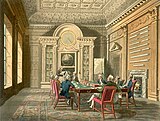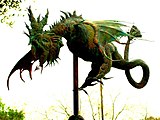Weather vane
Awind vane,weather vane,orweathercockis aninstrumentused for showing thedirectionof thewind.It is typically used as an architectural ornament to the highest point of a building. The wordvanecomes from theOld Englishwordfana,meaning "flag".

Although partly functional, wind vanes are generally decorative, often featuring the traditionalcockereldesign with letters indicating thepoints of the compass.Other common motifs include ships, arrows, and horses. Not all wind vanes have pointers. In a sufficiently strong wind, the head of the arrow or cockerel (or equivalent) will indicate the direction from which the wind is blowing.
Wind vanes are also found on smallwind turbinesto keep the wind turbine pointing into the wind.
History
[edit]
The oldest textual reference in China to a weather vane comes from theHuainanzi,dating from around 139 BC, which mentions a thread or streamer that another commentator interprets as "wind-observing fan" (hou feng shin,Hầu phong phiến).[1]
TheTower of the Windsin theagorain HellenisticAthensonce bore on its roof a weather vane in the form of a bronzeTritonholding a rod in his outstretched hand, rotating as the wind changed direction. Below this afriezedepicted the eight Greekwind deities.The eight-metre-high structure also featuredsundials,and awater clockinside. It dated from around 50 BC.[2]
Military documents from theThree Kingdomsperiod of China (220–280 AD) refer to the weather vane as "five ounces" (wu liang,Ngũ lưỡng), named after the weight of its materials.[1]By the third century, Chinese weather vanes were shaped like birds and took the name of "wind-indicating bird" (xiang feng wu,Tương phong ô). TheSanfu huangtu(Tam phụ hoàng đồ), a third-century book written by Miao Changyan about the palaces atChang'an,describes a bird-shaped weather vane situated on a tower roof.[1]
The oldest surviving weather vane with the shape of a rooster is theGallo di Ramperto,made in 820 and now preserved in theMuseo di Santa GiuliainBrescia,Lombardy.[3][4]

Pope Leo IV(in office 847 to 855) had a cock placed on theOld St. Peter's Basilicaor oldConstantinianbasilica.[5]
Pope Gregory I(in office 590 to 604) regarded the cock as "the most suitable emblem of Christianity", being the emblem ofSaint Peter(a reference toLuke 22:34in whichJesuspredicts that Peter will deny him three times before the rooster crows).[6][7]
As a result of this,[6]rooster representations gradually came into use as a weather vanes on church steeples, and in the ninth centuryPope Nicholas I[8](in office 858 to 867) ordered the figure to be placed on every church steeple.[9]
TheBayeux Tapestryof the 1070s depicts a man installing acockonWestminster Abbey.
One alternative theory about the origin of weathercocks on church steeples sees them as emblems of the vigilance of the clergy calling the people to prayer.[10]

Another theory says that the cock was not a Christian symbol[11]but an emblem of the sun[12]derived from the Goths.[13]
A few churches used weather vanes in the shape of theemblemsof their patron saints. TheCity of Londonhas two surviving examples. The weather vane ofSt Peter upon Cornhillis not in the shape of a rooster, but of akey;[14]whileSt Lawrence Jewry's weather vane has the form of agridiron(symbolisingSaint Lawrence).[15]

Early weather-vanes had very ornamental pointers, but modern weather-vanes usually feature simple arrows that dispense with the directionals because the instrument is connected to a remote reading station. An early example of this was installed in the Royal Navy'sAdmiraltybuilding in London – the vane on the roof was mechanically linked to a large dial in the boardroom so senior officers were always aware of the wind direction when they met.
Modernaerovanescombine the directional vane with ananemometer(a device for measuring the speed of the wind). Co-locating both instruments allows them to use the same axis (a vertical rod) and provides a coordinated readout.
World's largest weather vane
[edit]According to theGuinness World Records,theworld's largest weather vaneis aTío Pepesherryadvertisement located inJerez,Spain. The city ofMontague, Michiganalso claims to have the largest standard-design weather vane, being a ship and arrow which measures 48 feet (15 m) tall, with an arrow 26 feet (7.9 m) long.[16]
A challenger for the title of the world's largest weather vane is located inWhitehorse, Yukon.The weather vane is a retiredDouglas DC-3CF-CPY atop a swiveling support. Located at the Yukon Transportation Museum[17]besideWhitehorse International Airport,the weather vane is used by pilots to determine wind direction, used as a landmark by tourists and enjoyed by locals. The weather vane only requires a 5 knot wind to rotate.[18]
A challenger for the world's tallest weather vane[citation needed]is located inWestlock,Alberta.The classic weather vane that reaches to 50 feet (15 m) is topped by a 1942 Case Model D Tractor. This landmark is located at the Canadian Tractor Museum.
Slang term
[edit]The term "weather vane" is also aslang wordfor a politician who has frequent changes of opinion. TheNational Assembly of Quebechas banned the use of this slang term as an insult after its use bymembersof the legislature.[19]
Literary references
[edit]- A copper-plated antique weathervane is the subject of the mystery in the children's book/Young Adult book entitled "The Mystery of the Phantom Grasshopper" (Trixie Belden series #18) by Kathryn Kenny, 1977. ISBN 0-307-21589-X. Paperback.
Gallery
[edit]-
TheGallo di Ramperto,Museo di Santa GiuliainBrescia(Italy), the oldest surviving weather vane in the shape of a rooster in the world
-
Weather vane with dial,New Register House,Edinburgh, Scotland, UK
-
Admiralty boardroom, 1808; a wind indicator can be seen on the end wall.
-
Tío Pepe weather vane inJerez,Guinness world recordof the largest weather vane that works
-
The Douglas DC-3 that now serves as a weather vane atYukon Transportation Museumlocated beside the Whitehorse International Airport.
-
A "jin-pole"being used to install a weather vane atop the 200 foot steeple of a church in Kingston, New York.
-
Weathercock with verdigris patina
-
Huge weather vane inVilniusis among the largest in Europe
-
Weather vane (video)
-
Creuë gibbet weather vane dating from the 17th century (France)
-
Whirligigweather vane at theMinnesota History Center
See also
[edit]- Anemoscope
- Apparent wind indicator,in sailing
- List of weather instruments
- Weather station
- Windsock,in aviation
References
[edit]- ^abcNeedham, Joseph; Ling, Wang (1959),Science and Civilisation in China: Mathematics and the Sciences of the Heavens and the Earth,vol. 3, Cambridge University Press, p. 478
- ^Noble, Joseph V.;Price, Derek J. de Solla(October 1968). "The Water Clock in the Tower of the Winds".American Journal of Archaeology.72(4): 345–355 (353).doi:10.2307/503828.JSTOR503828.S2CID193112893.
- ^Rossana Prestini,Vicende faustiniane,in AA.VV.,La chiesa e il monastero benedettino di San Faustino Maggiore in Brescia,Gruppo Banca Lombarda, La Scuola, Brescia 1999, p. 243
- ^Fedele Savio,Gli antichi vescovi d'Italia. La Lombardia,Bergamo 1929, p. hi 188
- ^ST PETER'S BASILICA.ORG - Providing information on St. Peter's Basilica and Square in the Vatican City - The Treasury Museum[1]
- ^abJohn G. R. Forlong,Encyclopedia of Religions:A-d - Page 471
- ^Edward Walford; George Latimer Apperson (1888).The Antiquary: A Magazine Devoted to the Study of the Past.Vol. 17. E. Stock. p. 202.
- ^Jerry Adler; Andrew Lawler (June 2012)."How the Chicken Conquered the World".Smithsonian.
- ^Bulletin of the Pennsylvania Museum.Vol. 1–5. Pennsylvania Museum of Art, Pennsylvania Museum and School of Industrial Art, Philadelphia Museum of Art. 1906. p. 14.
- ^Thomas Ignatius M. Forster,Circle of the Seasons,p. 18
- ^William White,Notes and Queries
- ^Hargrave Jennings,Phallicism,p. 72
- ^William Shepard Walsh,A Handy Book of Curious Information
- ^"History of London: Vanity and Wind".Wordpress. Archived fromthe originalon 13 October 2016.Retrieved1 June2016.
- ^"Our Weather Vane".St Lawrence Jewry.Retrieved1 June2016.
- ^"The World's Largest Weather Vane - Ella Ellenwood".Archived fromthe originalon 2012-02-29.Retrieved2010-06-01.
- ^goytm.ca
- ^"DC-3 CF-CPY: The World's Largest Weather Vane - ExploreNorth".ExploreNorth.Retrieved2010-02-13.
- ^"Quebec bans 'weathervane' insult".Metro.2007-10-17. Archived fromthe originalon 2007-10-23.Retrieved2019-06-18.
Further reading
[edit]- Bishop, Robert; Coblentz, Patricia (1981),A Gallery of American Weather Vanes and Whirligigs,New York: Dutton,ISBN9780525931515
- Burnell, Marcia (1991),Heritage Above: a tribute to Maine's tradition of weather vanes,Camden, ME: Down East Books,ISBN9780892722785
- Crépeau, Pierre; Portelance, Pauline (1990),Pointing at the Wind: the weather-vane collection of the Canadian Museum of Civilization,Hull, Quebec: Canadian Museum of Civilization,ISBN9780660129044
- Fitzgerald, Ken (1967).Weathervanes & Whirligigs.New York: C. N. Potter.
- Kaye, Myrna (1975),Yankee Weathervanes,New York: Dutton,ISBN9780525238591
- Klamkin, Charles (1973),Weather Vanes: The history, design and manufacture of an American folk art,New York: Hawthorn Books,OCLC756017
- Lane Arts Council (Or.) (1994),Whirligigs & Weathervanes,Eugene, OR: Visual Arts Resources,OCLC33052846
- Lynch, Kenneth; Crowell, Andrew Durkee (1971),Weathervanes,Architectural Handbook series, Canterbury, CN: Canterbury Publishing Company,OCLC1945107
- Messent, Claude John Wilson (1937),The Weather Vanes of Norfolk & Norwich,Norwich: Fletcher & Son Limited,OCLC5318669
- Miller, Steve (1984),The Art of the Weathervane,Exton, PA: Schiffer Pub.,ISBN9780887400056
- Mockridge, Patricia; Mockridge, Philip (1990),Weather Vanes of Great Britain,London: Hale,ISBN9780709037224
- Needham, Albert (1953),English Weather Vanes, their stories and legends from medieval to modern times,Haywards Heath, Sussex: C. Clarke,OCLC1472757
- Nesbitt, Ilse Buchert; Nesbitt, Alexander (1970),Weathercocks and Weathercreatures; some examples of early American folk art from the collection of the Shelburne Museum, Vermont,Newport, RI: Third & Elm Press,OCLC155708
- Pagdin, W. E. (1949).The Story of the Weather Cock.Stockton-on-Tees: E. Appleby.
- Reaveley, Mabel E.; Kunhardt, Priscilla (1984),Weathervane Secrets,Dublin, NH: W. L. Bauhan,ISBN9780872330757
- Westervelt, A. B.; Westervelt, W. T. (1982),American Antique Weather Vanes: The Complete Illustrated Westervelt Catalog of 1883,New York: Dover,ISBN9780486243962
External links
[edit]![]() Media related toWeather vanesat Wikimedia Commons
Media related toWeather vanesat Wikimedia Commons













